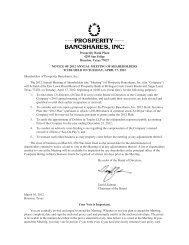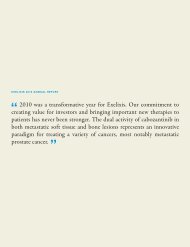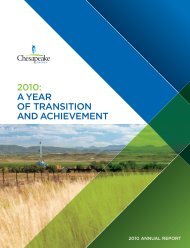goodrich petroleum corporation - RR DONNELLEY FINANCIAL
goodrich petroleum corporation - RR DONNELLEY FINANCIAL
goodrich petroleum corporation - RR DONNELLEY FINANCIAL
You also want an ePaper? Increase the reach of your titles
YUMPU automatically turns print PDFs into web optimized ePapers that Google loves.
the ultimate amount of recoverable proved and probable oil and natural gas reserves that will be produced from a<br />
field, the timing of this future production, future costs to produce the oil and natural gas, and future inflation<br />
levels. The need to test a property for impairment can be based on several factors, including a significant<br />
reduction in sales prices for oil and/or natural gas, unfavorable adjustments to reserves or other changes to<br />
contracts, environmental regulations or tax laws. We cannot predict the amount of impairment charges that may<br />
be recorded in the future.<br />
Asset Retirement Obligations<br />
We make estimates of the future costs of the retirement obligations of our producing oil and natural gas<br />
properties in order to record the liability as required by the applicable accounting standard. This requirement<br />
necessitates us to make estimates of our property abandonment costs that, in some cases, will not be incurred<br />
until a substantial number of years in the future. Such cost estimates could be subject to significant revisions in<br />
subsequent years due to changes in regulatory requirements, technological advances and other factors which may<br />
be difficult to predict.<br />
Income Taxes<br />
We are subject to income and other related taxes in areas in which we operate. When recording income tax<br />
expense, certain estimates are required by management due to timing and the impact of future events on when<br />
income tax expenses and benefits are recognized by us. We periodically evaluate our tax operating loss and other<br />
carry-forwards to determine whether a gross deferred tax asset, as well as a related valuation allowance, should<br />
be recognized in our financial statements.<br />
Accounting for uncertainty in income taxes requires that we recognize the financial statement benefit of a<br />
tax position only after determining that the relevant tax authority would more likely than not sustain the position<br />
following an audit. For tax positions meeting the more-likely-than-not threshold, the amount recognized in the<br />
financial statements is the largest benefit that has a greater than 50 percent likelihood of being realized upon<br />
ultimate settlement with the relevant tax authority. See Note 1—“Description of Business and Accounting<br />
Policies-Income Taxes” and Note 6—“Income Taxes” in the Notes to Consolidated Financial Statements in Part<br />
II Item 8 of this Annual Report on Form 10-K.<br />
Share-Based Compensation Plans<br />
For all new, modified and unvested share-based payment transactions with employees, we measure the fair<br />
value on the grant date and recognize it as compensation expense over the requisite period. The fair value of each<br />
option award is estimated using a Black-Scholes option valuation model that requires us to develop estimates for<br />
assumptions used in the model. The Black-Scholes valuation model uses the following assumptions: expected<br />
volatility, expected term of option, risk-free interest rate and dividend yield. Expected volatility estimates are<br />
developed by us based on historical volatility of our stock. We use historical data to estimate the expected term of<br />
the options. The risk-free interest rate for periods within the expected life of the option is based on the U.S. Treasury<br />
yield in effect at the grant date. Our common stock does not pay dividends; therefore the dividend yield is zero. The<br />
fair value of restricted stock is measured using the close of the day stock price on the day of the award.<br />
New Accounting Pronouncements<br />
See Note 1—“Description of Business and Accounting Policies”—“New Accounting Pronouncements” in<br />
the Notes to Consolidated Financial Statements in Part II Item 8 of this Annual Report on Form 10-K.<br />
Off-Balance Sheet Arrangements<br />
We do not currently use any off-balance sheet arrangements to enhance our liquidity and capital resource<br />
positions, or for any other purpose.<br />
55











